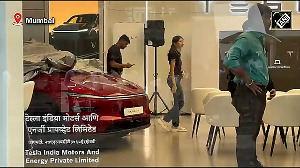That is the first open avowal by the government on the importance of Sainik Schools for nurturing prospective leaders for the armed forces. This well-meant grant-in-aid should give the beleaguered Sainik Schools a leg up as it will help to maintain/better the existing infrastructure. A token amount but good beginning, but, as ever, the devil lurks in the details. As we will see later, it does not address the core issues that caused the post-1990 failure of Sainik Schools to be a fecund nursery of military officers, and thereby triggering a crippling intake-deficit in the officer cadre of the three services.
The Rashtriya Indian Military College, RIMC, the Military Schools and the Sainik Schools were envisaged as feeders to the National Defence Academy and the Service Academies. The RIMC and the five Military Schools come under the army's Directorate of Military Training and its outlay is met from the army budget.
The Sainik Schools -- the brainchildren of then defence minister V K Krishna Menon -- were midwived under the aegis of the Sainik Schools Society (SSS) in 1961 as a hybrid dual-managed by both the Centre and the states (thus congenitally tailor-made for passing the buck).
The states were to provide the land, infrastructure, maintenance and scholarship, but the obligations weren't formalised (as the Centre and all the states were under Congress Party's thumb, nobody then foresaw multipolar polity and Centre-states bones of contention lingering unresolved).
To ensure mainly bright 9-year-old boys from the indigent strata joined these schools, the states were mandated to hand out merit-cum-means scholarship to the cadets depending on the parents' income. The financial support, however, varies from state to state because of the absence of an officially documented contract.
As the SSS doesn't have its own budget, the ministry of defence now dishes up Rs 15 crores to it from the defence ministry's serving (a chunk of which is consumed by SSS as overheads). The states/parents have to bear the rest of the costs.
The Supreme Court in 1989 directed the SSS to extend pension and gratuity to all employees. The SSS didn't have the means, the states looked the other way, so the parents had to cough up, resulting in spiralling fees. Sainik Schools, unlike the RIMC and Military Schools, thus became nobody's baby -- superintended by the defence ministry, hosted by the states and bankrolled by the parents!
Ever heard of the parents footing the salary and pension of the staff in a government-owned school? Absurd, right? No wonder the bill per student of Rs 11,000 in 1989 zoomed to Rs 55,000 this year.
A quick back-of-the-envelope estimation portends that the implementation of the Sixth Pay Commission rates will entail additional expenditure of Rs 20 lakhs to Rs 25 lakhs per school. Who will meet it? Naturally the parents, which should squeeze these hapless beasts of burden further.
With the fees tearing like a convoy without brakes, gifted lads from the peripheries had to turn off their Sainik School dream. Meanwhile, green avenues opened thick and fast in the civvy street. And as the parents were paying up goodly sums, the students had hardly any motivation to don the once-coveted fatigues. To stoke the fire, the staff turned jittery as they were compelled to keep guessing when the unconscionable fees would force students to cease joining the school and deprive them of their livelihood, and even pension. Result: The ingress into the forces from Sainik Schools thinned to a trickle.
In sum, obscene fees and to some extent edgy staff are the two top reasons for the well-below-par performance of Sainik Schools, not exactly creaky infrastructure. Though beneficial in a different way, the Rs 44 crore pledge will ultimately end like water off a duck's back; it will neither unburden the fee-paying parents nor induce certitude among the staff.
If the finance minister picked up the annual tab of all 22 schools, he knew it would be a recurring burden to the tune of Rs 80 crores to Rs 85 crores to the exchequer. So, instead of grasping the bull by its horns, I suspect the politician in him emerged to the fore and opted for the easy way out by earmarking the one-time subsidy. But he surely knows that national security doesn't come cheap. A nation neglects its security at its peril. And Sainik Schools are a pivotal cog in the security apparatus.
To resuscitate the Sainik Schools to its bygone renown, here's a rough-and-ready recipe:
- The military has historically served as a vehicle for social mobility. But due to the skyrocketing of fees and the shirking of state governments to hike the scholarship pro rata, Sainik Schools, once glorified as the Poor Man's Public Schools, became unaffordable to the poor man! These schools must identify promising kids likely to eye becoming service officers as upward mobility, and groom them gratis;
- The anachronistic nature of the Sainik Schools Society is another reason for the underachievement of Sainik Schools. The SSS is a bureaucratic masterpiece. Though an autonomous body registered under the Societies Act, the Supreme Court has deemed it 'state' for all practical purposes. The honorary secretary and two inspecting officers virtually lord over the Sainik Schools. Its intricate functioning and reporting credo are right out of Ripley's Believe It or Not! but keeping in mind the space constraints, I shall skip elaborating it (and rob you off some mirth).
To facilitate the rebirth of Sainik Schools, the SSS needs to be dismantled hook, line and sinker. Since the prevailing Centre-state collaborative model has become a dead duck, the Centre must take charge to dissolve the SSS, bring all Sainik Schools under the Integrated Defence Staff headquarters (like the National Defence Academy) and bear its entire expenses including the salary and pension of the staff, which must be budgeted for annually.
The expenditure will be worth it as it will ensure perpetual supply to the academies, thus fulfilling the original aim of the venture.
Let me reiterate: It's patent lack of access to Sainik Schools to the son of everyman -- a probable officer-aspirant -- owing to the sky-high fees that has precipitated the intake shortage. Inferior infrastructure is incidental to the crisis. If the defence ministry wasn't myopic and had responded in 1989 itself by embracing the salary and pension obligation, the present pickle could have been nipped in the bud. Its chronic inaction has almost laid waste what it begat in 1961. The ministry, however, has an opportunity now to make amends for its historic blunder -- take over all 22 Sainik Schools.
Since the issue is organically linked to national security, one expects another dollop of munificence from the finance minister, and hopes that he and the defence minister shall join forces to cleave through the red tape to sanction the necessary budgetary allocation for all Sainik Schools.
M P Anil Kumar is a former fighter pilot.






